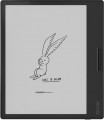Button control
The presence of a touch screen allows you to configure and control the device using the display. However, for greater convenience, in many e-readers, regardless of the type of screen, the
buttons still act as the main controls. Firstly, they can be pressed with gloves or wet hands. Secondly, holding a book with two hands is much easier to press the button to turn the page than to swipe your finger across the screen.
E-book formats
File formats supported by the reader that contain text (and sometimes graphic information). The most popular in the CIS are, in particular,
FB2,
TXT,
HTML,
WORD (DOC),
RTF,
ePUB,
Djvu and
PDF.
Photo/video formats
File formats supported by the reader that contain multimedia information — graphics or video. The most popular image file formats are, among others,
JPG(the standard format for modern digital photography), BMP and GIF; video files —
MP4, MPG,
AVI, 3GP (video format for mobile devices),
FLV, MOV.
Other formats
Many advanced reader models are able to "perceive" not only e-readers, graphic files and videos, but also other file formats. The most common support for music files:
MP3, WMA, in especially advanced cases —
AAC, OGG, lossless formats APE and
FLAC. Of the non-musical formats, some readers support
ZIP and RAR archive files, as well as Microsoft Office documents (PPT(X), XLS(X))
Operating system
A software product that ensures the correct operation of the installed software and convenient management of e-book functions. Conventionally, the family of "readers" is divided into two large camps: some work under the
Android OS (in various versions of
Android 10,
Android 11,
Android 12,
Android 13,
Android 14), others run Linux. The Android system is not always well adapted to the features of the e-book interface, but a significant trump card up its sleeve is support for installing applications from the Google store.
Linux -led readers stay afloat longer in offline mode, but most of them cannot be installed with third-party applications.
CPU speed
The frequency of the built-in e-book processor is one of the main indicators that determine its performance (the speed of copying files to the built-in memory, opening larger files, loading Internet pages, etc.). On the other hand, this indicator is not decisive and can only be used for comparison in books of the same model range.
RAM
The amount of the reader's own RAM, that is, the memory used for temporary data storage during operation. The speed of the e-book directly depends on the amount of RAM, especially when working with large files. So the average value can be considered
RAM 1 GB and
2 GB, and more advanced models have
3 GB,
4 GB and even
6 GB of memory.
Card reader
Possibility of expansion of own built-in memory at the expense of replaceable memory cards. In addition to increasing the amount of memory, such a medium facilitates the exchange of information between an e-book and other devices: for example, you can download a book to a laptop equipped with a card reader, write it to a memory card and install the card in an e-book. Note that at the present time several types of memory cards are actively used, and not all of them are mutually compatible; therefore, when buying a book with a memory card slot, you need to pay special attention to the type of cards supported.
Multimedia
—
Headphone output(3.5 mm). A standard mini-jack connector that allows you to connect headphones to an audiobook. Most consumer-grade headphones currently being produced are equipped with a 3.5 mm plug, which makes this connector very versatile. Usually, the presence of a headphone output in an audiobook means that it is equipped with a built-in media player, and headphones can also be used to read text from the screen.
—
Dictaphone. The ability to use an e-book as a voice recorder, to record speech and other sounds. To do this, the device is equipped with its own built-in microphone, and to play the recorded material, an output to headphones and/or its own speaker is provided.
—
Built-in speaker. The audiobook has its own built-in speaker. The speaker can be used to play audio files, video soundtrack, or read text from the screen; the presence of a speaker, usually, implies the presence in the reader of at least one of the above functions.
—
Built-in dictionary. The presence in the software set of the book of an electronic dictionary (or several dictionaries), which allows the translation of individual words and expressions. This feature can be especially useful for those who like to read books in foreign languages.
— Built-in browser. The presence of a built-in browser allows you to view Internet
...pages on the screen of the reader; connection to the Internet is carried out using Wi-Fi.
— Built-in audio player. The ability to use an e-book to play audio files through headphones or a built-in speaker. The most common support for MP3 music files; some models are capable of playing other types of audio files, such as WMA, AAC, OGG, and even the lossless APE and FLAC formats.
— Voice reading. The ability of an e-book to read the written text and output it to external speakers or connected headphones. The voice sounds quite monotonous and with a noticeable "computer" accent. Pronunciation, usually, is at a level sufficient for understanding.
— Accelerometer. A device that reacts to shaking and changes in the position of an e-book in space. The accelerometer provides advanced control options: for example, you can change the screen orientation from portrait to landscape and vice versa by simply turning the reader to the appropriate position, switch the music track by shaking, etc.
